custer
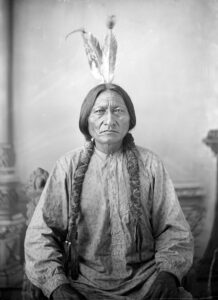 Sitting Bull was a Hunkpapa Lakota leader who led his people during years of resistance against United States government policies. The Hunkpapa Lakota is a branch of the Sioux tribe. Sitting Bull was a rather charismatic person, and people were willing to follow him because of it. He was a rather mysterious historical figure. He was not impulsive, nor was he calm. Sitting Bull had a strange personality. He was most serious when he seemed to be joking. He also possessed the power of sarcasm, and he used it to his advantage. These things are likely what made him a good leader for his people.
Sitting Bull was a Hunkpapa Lakota leader who led his people during years of resistance against United States government policies. The Hunkpapa Lakota is a branch of the Sioux tribe. Sitting Bull was a rather charismatic person, and people were willing to follow him because of it. He was a rather mysterious historical figure. He was not impulsive, nor was he calm. Sitting Bull had a strange personality. He was most serious when he seemed to be joking. He also possessed the power of sarcasm, and he used it to his advantage. These things are likely what made him a good leader for his people.
Sitting Bull was a man given to having visions, and before the Battle of the Little Bighorn, he had a vision in which he saw many soldiers, “as thick as grasshoppers,” falling upside down into the Lakota camp. The Hunkpapa Lakota people took the vision as a sign of a major victory in which many soldiers would be killed…and maybe it was. Just three weeks later, on June 25, 1876, the confederated Lakota tribes, along with the Northern Cheyenne tribe, defeated the 7th Cavalry under Lieutenant Colonel George Armstrong Custer, decimating Custer’s battalion. The battle and it’s timing seemed to bear out Sitting Bull’s prophetic vision. Again, Sitting Bull’s leadership inspired his people to 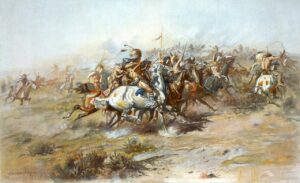 a major victory.
a major victory.
Of course, the United States government immediately sent thousands more soldiers to the area, in response to the battle. Any Indians who were in small groups or alone were a target, as were villages of peaceful Indians. Many were forced to surrender over the next year, but Sitting Bull refused to. In May 1877, he led his band north to Wood Mountain, North-West Territories, which is now Saskatchewan. Canada. Sitting Bull stayed in that area until 1881, at which time he and most of his band returned to US territory and surrendered to US forces.
Sitting Bull’s charismatic personality helped him out again when he went to work as a performer with Buffalo 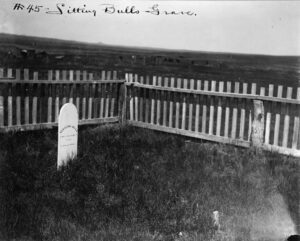 Bill’s Wild West show for a while, before returning to the Standing Rock Agency in South Dakota. That became one of the biggest mistakes Sitting Bull would ever make. Due to fears that he would use his influence to support the Ghost Dance movement, Indian Service agent James McLaughlin at Fort Yates ordered his arrest on December 15, 1890. Sitting Bull’s followers refused to go quietly, and in the struggle with police, Sitting Bull was shot in the side and head by Standing Rock policemen Lieutenant Bull Head and Red Tomahawk. His body was taken to nearby Fort Yates for burial. In 1953, his Lakota family exhumed what were believed to be his remains, reburying them near Mobridge, South Dakota, near his birthplace.
Bill’s Wild West show for a while, before returning to the Standing Rock Agency in South Dakota. That became one of the biggest mistakes Sitting Bull would ever make. Due to fears that he would use his influence to support the Ghost Dance movement, Indian Service agent James McLaughlin at Fort Yates ordered his arrest on December 15, 1890. Sitting Bull’s followers refused to go quietly, and in the struggle with police, Sitting Bull was shot in the side and head by Standing Rock policemen Lieutenant Bull Head and Red Tomahawk. His body was taken to nearby Fort Yates for burial. In 1953, his Lakota family exhumed what were believed to be his remains, reburying them near Mobridge, South Dakota, near his birthplace.
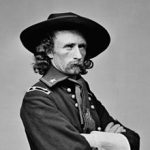
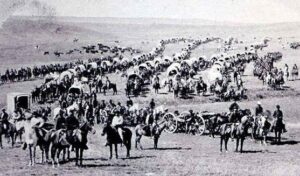 There was so much controversy over the control of the Black Hills. The Indians were told that the White man would stay out of the Black Hills, but when gold was discovered there, all bets were off. Before his defeat at the Battle of Little Big Horn, while he was still a Lieutenant Colonel, George Custer rode with his crew to the Black Hills of South Dakota in search of a location for a fort. That Custer Expedition of 1874 became a defining moment in the story of the Black Hills coming under the control of the United States. Things really got started in 1872, when Secretary of the Interior Columbus Delano, basically set the stage for the expedition to the Black Hills. Delano was responsible for the Sioux territorial rights in the region. Delano sent a letter dated March 28, l872, which stated, “I am inclined to think that the occupation of this region of the country is not necessary to the happiness and prosperity of the Indians, and as it is supposed to be rich in minerals and lumber it is deemed important to have it freed as early as possible from Indian occupancy. I shall, therefore, not oppose any policy which looks first to a careful examination of the subject… If such an examination leads to the conclusion that country is not necessary or useful to Indians, I should then deem it advisable…to extinguish the claim of the Indians and open the territory to the occupation of the whites.”
There was so much controversy over the control of the Black Hills. The Indians were told that the White man would stay out of the Black Hills, but when gold was discovered there, all bets were off. Before his defeat at the Battle of Little Big Horn, while he was still a Lieutenant Colonel, George Custer rode with his crew to the Black Hills of South Dakota in search of a location for a fort. That Custer Expedition of 1874 became a defining moment in the story of the Black Hills coming under the control of the United States. Things really got started in 1872, when Secretary of the Interior Columbus Delano, basically set the stage for the expedition to the Black Hills. Delano was responsible for the Sioux territorial rights in the region. Delano sent a letter dated March 28, l872, which stated, “I am inclined to think that the occupation of this region of the country is not necessary to the happiness and prosperity of the Indians, and as it is supposed to be rich in minerals and lumber it is deemed important to have it freed as early as possible from Indian occupancy. I shall, therefore, not oppose any policy which looks first to a careful examination of the subject… If such an examination leads to the conclusion that country is not necessary or useful to Indians, I should then deem it advisable…to extinguish the claim of the Indians and open the territory to the occupation of the whites.”
It was the beginning of major trouble in the Black Hills, because Delano’s remarks were in direct contradiction of terms defined in the 1868 Laramie Treaty which states: “…no persons except those designated herein … shall ever be permitted to pass over, settle upon, or reside in the territory described in this article.” Delano singlehandedly broke the treaty with the Indians and blew up the situation in the Black Hills. Basically, he thought the Indians wouldn’t see the value in the Black Hills that he saw…gold. Well, the gold didn’t interest them, but the land did. Delano stated that the major reasons for exploration was that “Americans and representatives in Dakota Territory felt that there was too much land allotted for too few Sioux (estimated to number from 15 to 25,000 in 1872); and the existence of mineral and natural resources in the area.”
The American economy wasn’t in good shape at that time. Experts think that the Delano letter and other previous reports and rumors regarding the wealth of the Black Hills were the real forces behind the expedition of the following year. General Alfred H. Terry of the Headquarters of the Department of Dakota in Saint Paul formally ordered the exploration of the Black Hills on June 8, 1874. Enter Custer…who was told to look for a site for Fort Abraham Lincoln, Dakota Territory, which ended up being located 7 miles south of Mandan, North Dakota, not in the Black Hills at all. Of course, the fort was likely to be used to protect the settlers and prospectors who were expected to flood the Black Hills. Custer’s expedition departed on July 2, 1874. Custer’s expedition, which was a mile long, included Custer, wearing a buckskin uniform, on his favorite bay thoroughbred at the head of ten Seventh Cavalry companies, followed by two companies of infantry, scouts, and guides. In all they were more than 1000 troops and one black woman, Sarah Campbell, the expedition’s 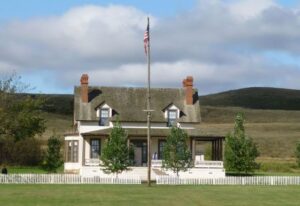 cook. The 110 canvas-topped wagons were pulled by six mule teams. In addition, they had horse-drawn Gatling guns and cannons, and three hundred head of cattle brought along to provide meat for the troops. The expedition even had a “Scientific corps” with them, which included a geologist and his assistant, a naturalist, a botanist, a medical officer, a topographical engineer, a zoologist, and a civilian engineer. Two miners, Horatio N. Ross and William T. McKay, were attached to the scientific corps. In addition, Custer brought a photographer, newspaper correspondents, the company’s band, hunting dogs, the son of US President Ulysses S. Grant, as well as his younger brothers, Tom and Boston. All to look for a site for a fort!!!
cook. The 110 canvas-topped wagons were pulled by six mule teams. In addition, they had horse-drawn Gatling guns and cannons, and three hundred head of cattle brought along to provide meat for the troops. The expedition even had a “Scientific corps” with them, which included a geologist and his assistant, a naturalist, a botanist, a medical officer, a topographical engineer, a zoologist, and a civilian engineer. Two miners, Horatio N. Ross and William T. McKay, were attached to the scientific corps. In addition, Custer brought a photographer, newspaper correspondents, the company’s band, hunting dogs, the son of US President Ulysses S. Grant, as well as his younger brothers, Tom and Boston. All to look for a site for a fort!!!
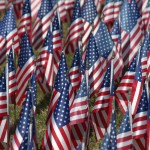
 It seems to me that with each Independence Day, the fight for our freedom grows more and more fierce. Our current political situation is not a matter of Republican against Democrat, but rather, Good against Evil. I suppose one might have their own opinion as to which side is which, but those who know me, know exactly where I stand. I am a firm believer in this statement by Thomas Jefferson, “When the people fear the government, there is tyranny. When the government fears the people, there is liberty.” The good news for the good people of this nation is that we know how to pray, and we know how to fight. What we don’t know how to do is to give up. It may take us a little while, but with God’s help we will prevail…and God is on our side.
It seems to me that with each Independence Day, the fight for our freedom grows more and more fierce. Our current political situation is not a matter of Republican against Democrat, but rather, Good against Evil. I suppose one might have their own opinion as to which side is which, but those who know me, know exactly where I stand. I am a firm believer in this statement by Thomas Jefferson, “When the people fear the government, there is tyranny. When the government fears the people, there is liberty.” The good news for the good people of this nation is that we know how to pray, and we know how to fight. What we don’t know how to do is to give up. It may take us a little while, but with God’s help we will prevail…and God is on our side.
Pretty much every year, my husband, Bob Schulenberg and I go to the Black Hills for the holiday. The fireworks 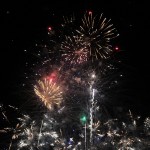
 display in Custer, South Dakota is one of the best we’ve ever seen. The amazing thing is that Custer is a really small town…in fact, it has a population of only about 2,314 people. That said, for them to put on such an amazing fireworks display is really cool. Pageant Hill starts filling up early, so if you are driving up there, you need to go well before dusk. Bob and I would rather walk up there, because it’s easy to find a place to sit when you don’t have a car, and when the show is over, we don’t have to wait for all that traffic to get back to our room. That fireworks display is one of the main highlights of the trip.
display in Custer, South Dakota is one of the best we’ve ever seen. The amazing thing is that Custer is a really small town…in fact, it has a population of only about 2,314 people. That said, for them to put on such an amazing fireworks display is really cool. Pageant Hill starts filling up early, so if you are driving up there, you need to go well before dusk. Bob and I would rather walk up there, because it’s easy to find a place to sit when you don’t have a car, and when the show is over, we don’t have to wait for all that traffic to get back to our room. That fireworks display is one of the main highlights of the trip.
Of course, the fireworks display is not the only thing Bob and I like to do in the Black Hills. Our main focus is hiking. There are so many beautiful trails in the area. We take a different one each day that we are there. There is no better way to experience freedom and liberty, than a hike in the woods. It is so peaceful out there, and 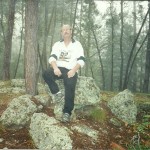
 absolutely beautiful. There are many places that you just can’t see driving down the road. Wildlife, mostly birds, because the bigger animals make themselves scarce…thankfully for the most part. I like seeing deer, but I draw the line at the mountain lions. There are no bears in the Black Hills, except at Bear Country USA, which is a wildlife park, and the bears don’t run free in the Black Hills. Bears don’t run free there, but we definitely do. Happy Independence Day everyone!! Let Freedom Ring!!!
absolutely beautiful. There are many places that you just can’t see driving down the road. Wildlife, mostly birds, because the bigger animals make themselves scarce…thankfully for the most part. I like seeing deer, but I draw the line at the mountain lions. There are no bears in the Black Hills, except at Bear Country USA, which is a wildlife park, and the bears don’t run free in the Black Hills. Bears don’t run free there, but we definitely do. Happy Independence Day everyone!! Let Freedom Ring!!!
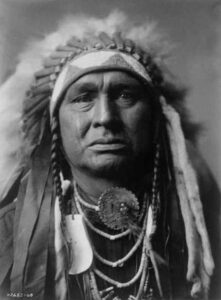 Joe Medicine Crow did not set out to become a war chief…much less the last surviving war chief, but when World War II drew the Unted States into the fight, Medicine Crow knew he couldn’t just sit back in his college dorm and refuse to help. Joe Medicine Crow was born on a reservation near Lodge Grass, Montana in 1913. Raised in the warrior tradition of the Crow, he was never one to shirk his duty in battle. He had some great warrior role models to fashion himself after, like his step-grandfather, who had been a scout for Custer at the infamous Battle of Little Bighorn, and his paternal grandfather Chief Medicine Crow who was one of the greatest Crow war heroes.
Joe Medicine Crow did not set out to become a war chief…much less the last surviving war chief, but when World War II drew the Unted States into the fight, Medicine Crow knew he couldn’t just sit back in his college dorm and refuse to help. Joe Medicine Crow was born on a reservation near Lodge Grass, Montana in 1913. Raised in the warrior tradition of the Crow, he was never one to shirk his duty in battle. He had some great warrior role models to fashion himself after, like his step-grandfather, who had been a scout for Custer at the infamous Battle of Little Bighorn, and his paternal grandfather Chief Medicine Crow who was one of the greatest Crow war heroes.
Before the war broke out, Medicine Crow enrolled at the University of Southern California and earned a master’s degree for his thesis, “The Effects of European Culture Contacts Upon the Economic, Social, and Religious Life of the Crow Indians.” With that, he became the first Crow to earn a master’s degree. After his graduation, he moved to Oregon to work at a Native American school and planned to pursue his Ph D, but then World War II broke out. Medicine Crow told a reporter for the Billings Gazette, “I had an uncle who had other plans for me…Uncle Sam.”
Medicine Crow hadn’t planned on entering the military, but he knew how to fight, and even while he was doing his duty to his country, he was still very aware of his family history. When he was a boy, his grandfather, Yellowtail put him through traditionally rigorous physical training meant to toughen him up. This included running in the snow barefoot and swimming in freezing rivers. His childhood was spent undergoing hardcore Spartan-style feats of strength, piledriving buffalo, riding horses bareback, swimming through mighty rivers, punching things, and running barefoot through snow-covered plains “uphill both ways.” He was taught to control his fear in the face of imminent peril, learned to hunt dangerous animals by himself, and trained his body to survive prolonged exposure to extreme temperatures. This training made him uniquely qualified for the hardships of a foot soldier. He came from a long line of famous warriors, and he kept them in mind when he was sent to Germany. He said, “I had a legacy to live up to.” Still, it was not something he told people about. That was his own legacy to live up to, and it was private. Throughout the war, he wore his war paint under his uniform, and he tucked a sacred yellow eagle feather under his helmet. He was determined to bring honor to his country and to his Crow people.
After the war, he worked for the Crow tribe and later became an appraiser for the Bureau of Indian Affairs, while also working as a Crow historian. While he didn’t get to go back to college, the University of Southern California (his alma mater) eventually awarded him an honorary doctorate in 2003, a degree I think he earned quite honorably.
“War Chief of the Crow Indians” isn’t a title that is given to just any warrior or chief. You don’t become a War Chief just because of your longevity of years or your physical strength. It’s an ancient, prestigious honorific bestowed only upon the bravest, the strongest warrior chiefs, and the only way to attain this hallowed title is by proving yourself in combat and unlocking the four achievements the Crow believed to be the most “insanely difficult” things a warrior can attempt in battle. These four major coups…leading a successful war party on a raid, capturing an enemy’s weapon, touching an enemy without killing him, and stealing an enemy’s horse. Some of those may sound odd to us, but to the Crow tribe, these were indeed major coups. These were difficult and dangerous tasks to attempt. In fact, they required that he put his life on the line by voluntarily bringing himself face-to-face with at least one warrior who is presumably in the process of actively trying to kill you without giving it a second thought. It was the Crow tribe’s way of ensuring that the chief leading them into battle was the bravest and best there was…and Joseph Medicine Crow was just that…the bravest and the best.
As an infantry scout, Private Medicine Crow got the opportunity to lead a group of men into battle in snow-covered battlefields of Western France while the Allies made their push from Paris towards Berlin…his first coup. It was during one particularly nasty portion of the battle for the Rhine, that Medicine Crow’s commanding officer ordered him to take a team of seven soldiers and lead them across a field of barbed wire, bullets, and artillery fire, grab some dynamite from an American position that had been utterly annihilated, and then assault the German bunkers and blow them up with TNT. It was a suicide mission, but according to Medicine Crow, his CO’s exact words were, “if anyone can do this, it’s probably you.”
His second and third coups followed quickly, when after being separated from his unit, Medicine Crow was sprinting through a back yard. He ran head on into a Nazi, who immediately lost his weapon. Not wanting to kill an unarmed man, Medicine Crow threw down his own weapon and proceeded to fist fight the Nazi. When the Nazi almost got the upper hand, Medicine Crow turned the tables and began to choke the life out of the guy…until the man started screaming for his mommy. That took “the kill” out of Medicine Crow, so he let the guy 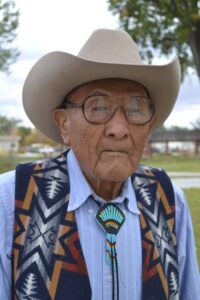 live. He took he German (and his rifle) as a prisoner of war.
live. He took he German (and his rifle) as a prisoner of war.
The fourth coup came in a rather unusual way. Joe and his men on a scouting mission deep behind enemy lines. While surveying the landscape for enemy troop movements, the small team of recon experts just happened to come across a small farm where some senior members of the German officer staff were hiding out…with their awesome thoroughbred racehorses. Seriously, how could Joseph Medicine Crow pass that up. So, he just had to steal them…and with that he had met all the requirements for becoming a “War Chief of the Crow Indians.” In August of 2009, Chief Medicine Crow was awarded the Presidential Medal of Freedom…the highest honor awarded to American civilians…for his combined military service and all the work he has done to help improve the lives of the people of the Crow people. The 95-year-old Medicine Crow personally led the ceremonial dance after the ceremony. Joseph Medicine Crow was the last surviving War Chief of the Crow Indians when he died in 2016, at 102 years old.
 Anyone who has spent much time in the Black Hills has most likely seen Deadwood, and knows it to be a historic gambling town where many famous Wild West characters hung out and died. Legends like Wild Bill Hickok and Calamity Jane each left their mark. Hickok, a legendary man even in his own lifetime, was shot in the back of the head by Jack McCall, while playing poker at the No. 10 Saloon on August 2, 1876. Calamity Jane was renowned for her excellent marksmanship, as well as her preference for men’s clothing, and brash behavior.
Anyone who has spent much time in the Black Hills has most likely seen Deadwood, and knows it to be a historic gambling town where many famous Wild West characters hung out and died. Legends like Wild Bill Hickok and Calamity Jane each left their mark. Hickok, a legendary man even in his own lifetime, was shot in the back of the head by Jack McCall, while playing poker at the No. 10 Saloon on August 2, 1876. Calamity Jane was renowned for her excellent marksmanship, as well as her preference for men’s clothing, and brash behavior.
Deadwood also had, in addition to its tough individuals, others such as Reverend Henry W. Smith. Preacher Smith was the first Methodist minister to come to the Black Hills. Smith was mysteriously murdered on Sunday, August 20, 1876, while walking to Crook City to deliver a sermon. These individuals are just a few of the many notables buried in Mount Moriah Cemetary, which was established in 1877 or 1878.
That’s all well known to many people, but some may not know that the settlement of Deadwood began illegally in the 1870s on land which had been granted to the Native Americans. In 1874, Colonel George Armstrong Custer led an expedition into the Black Hills and announced the discovery of gold on French Creek near what is now Custer, South Dakota. That announcement ushered in the Black Hills Gold Rush and gave rise to the new and lawless town of Deadwood. In 1875, a miner named John Pearson found gold in a narrow canyon in the Northern Black Hills. This canyon became known as “Deadwood Gulch,” because of the many dead trees that lined the canyon walls at that time. The name stuck. Try as they might, the government couldn’t keep the situation under wraps, in order to honor the 1868 Treaty of Fort Laramie, which forever ceded the Black Hills to the Lakota-Sioux. The government dispatched several military units to forts in the surrounding area to keep people from entering the Hills. However, people illegally entered the area anyway, searching for gold or adventure. Despite the efforts of the military and federal government. They were driven by dreams and greed.
Once Deadwood was established, the mining camp was quickly swarming with thousands of prospectors searching for an easy way to get rich. Fred and Moses Manuel, claimed the Homestake Mine, which proved to be the most profitable in the area. Although the Manuels had been lucky, others were not so fortunate. Most of the early population was in Deadwood to mine for gold, but the lawless town naturally attracted a crowd of rough and shady characters too. These particular individuals made the early days of Deadwood rough and wild. 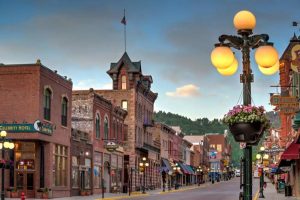 A mostly male population eagerly patronized the many saloons, gambling establishments, dance halls, and brothels. These establishments were considered legitimate businesses and were well known throughout the area.
A mostly male population eagerly patronized the many saloons, gambling establishments, dance halls, and brothels. These establishments were considered legitimate businesses and were well known throughout the area.
In 1890, the railroad connected the town to the outside world. Illegal beginnings aside, Deadwood was a town that was now here to stay. The treaty with the Lakota-Sioux was broken and the Black Hills would never again belong to them. As unfair as it was to break the treaty, I don’t think that it could have lasted forever anyway, because the United Stated was going to be populated from coast to coast one way or the other.
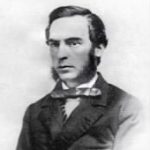
 These days, as wars are fought, we often see, hear, and read the stories written by embedded reporters. It seems almost commonplace, and yet in reality, whenever these reporters go into a war zone, they are risking almost as much as the soldiers. Of course, the reporters don’t go out to attack the enemy, but because of where they are, and who they are with, they make themselves a target to the enemy too. Even as far back as the World Wars, embedded reporters seemed like a common phenomenon, but who would have thought of an embedded reporter as far back as the Indian wars? I certainly didn’t. Nevertheless, journalists were there. One such journalist, who became famous, mostly because he was killed, was Marcus Kellogg, who was traveling with Custer’s 7th Cavalry. Kellogg was a native of Ontario, Canada before immigrating to New York with his family in 1835. As a young man he mastered the art of the telegraph and went to work for the Pacific Telegraphy Company in Wisconsin. During the Civil War, he felt led toward a different calling. He left his career in telegraphy, and became a journalist. Then in 1873, he again felt the calling to change his life, when he decided to move west to the frontier town of Bismarck in Dakota Territory and became the assistant editor of the Bismarck Tribune.
These days, as wars are fought, we often see, hear, and read the stories written by embedded reporters. It seems almost commonplace, and yet in reality, whenever these reporters go into a war zone, they are risking almost as much as the soldiers. Of course, the reporters don’t go out to attack the enemy, but because of where they are, and who they are with, they make themselves a target to the enemy too. Even as far back as the World Wars, embedded reporters seemed like a common phenomenon, but who would have thought of an embedded reporter as far back as the Indian wars? I certainly didn’t. Nevertheless, journalists were there. One such journalist, who became famous, mostly because he was killed, was Marcus Kellogg, who was traveling with Custer’s 7th Cavalry. Kellogg was a native of Ontario, Canada before immigrating to New York with his family in 1835. As a young man he mastered the art of the telegraph and went to work for the Pacific Telegraphy Company in Wisconsin. During the Civil War, he felt led toward a different calling. He left his career in telegraphy, and became a journalist. Then in 1873, he again felt the calling to change his life, when he decided to move west to the frontier town of Bismarck in Dakota Territory and became the assistant editor of the Bismarck Tribune.
Then, while returning from a trip to the East, Kellogg happened to be on the same train as George Custer and his wife, Elizabeth. Custer was on his way to Fort Abraham Lincoln, near Bismarck, where he was going to lead the 7th Cavalry in a planned assault on several bands of Indians who had refused to be confined to reservations. There journey was delayed by an unusually heavy winter storm. The train became snowbound. Being the expert that he was, Kellogg improvised a crude telegraph key, connected it to the wires running alongside the track, and sent a message ahead to the fort asking for help. Custer’s brother, Tom, arrived soon after with a sleigh to rescue them. Custer had enjoyed being made famous by the nation’s newspapers during the Civil War, and now, as he prepared for what he hoped would be his greatest victory ever, Custer wanted to make sure his glorious deeds would be adequately covered in the press. Initially, Custer had planned to take his old friend Clement Lounsberry, who was Kellogg’s employer at the Tribune, with him into the field with the 7th Cavalry, but after meeting Kellogg, he chose him to go instead, mostly because Custer had been impressed by his resourcefulness with a telegraph key.
That one chance event in the winter of 1876, took Kellogg in an unexpected direction…toward the Little Big Horn. When Custer led his soldiers out of Fort Abraham Lincoln and headed west for Montana on May 31, Kellogg rode with him. During the next few weeks, Kellogg filed three dispatches from the field to the Bismarck Tribune, which in turn passed the stories on to the New York Herald. Wanting to make sure the word got out, Custer also sent three anonymous reports on his progress to the Herald. Kellogg’s first dispatches, dated May 31 and June 12, recorded the progress of the expedition westward. His final report, dated June 21, came from the army’s camp along the Rosebud River in southern Montana, not far from the Little Big Horn River. “We leave the Rosebud tomorrow,” Kellogg wrote, “and by the time this reaches you we will have met and fought the red devils, with what result remains to be seen.” The results, of course, were disastrous. Four days later, Sioux and Cheyenne warriors wiped out Custer and his men along the Little Big Horn River. Kellogg was the only journalist to witness the final moments of Custer’s 7th Cavalry. Had he been able to file a story he would have become a national celebrity, but Kellogg did not live to tell the tale, he died alongside Custer’s soldiers.
On July 6, the Bismarck Tribune printed a special extra edition with a top headline reading: “Massacred: Gen. Custer and 261 Men the Victims.” Further down in the column, in substantially smaller type, a sub-headline reported: “The Bismarck Tribune’s Special Correspondent Slain.” The article went on to report, “The body of Kellogg alone remained unstripped of its clothing, and was not mutilated.” The reporter speculated that this 
 might have been a result of the Indian’s “respect for this humble shover of the lead pencil.” I doubt that the Sioux and Cheyenne respected Kellogg for his journalistic abilities, but his death in one of the most notorious events in the nation’s history made him something of an martyr among newspapermen. The New York Herald later erected a monument to Kellogg over the supposed site of his grave on the Little Big Horn battlefield. Being an embedded journalist might be exciting, but it’s quite risky too.
might have been a result of the Indian’s “respect for this humble shover of the lead pencil.” I doubt that the Sioux and Cheyenne respected Kellogg for his journalistic abilities, but his death in one of the most notorious events in the nation’s history made him something of an martyr among newspapermen. The New York Herald later erected a monument to Kellogg over the supposed site of his grave on the Little Big Horn battlefield. Being an embedded journalist might be exciting, but it’s quite risky too.
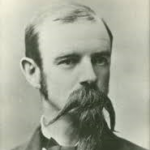 In my many hikes to the Harney Peak lookout, I have noticed many times the marker there for Dr Valentine McGillycuddy. I suppose that the main reason it has stuck in my head is because of my grandfather, George Byer, who used to call our house and ask for Mrs McGillycuddy. We always knew it was Grandpa, but we went along with the joke anyway. Of course, Grandpa’s Mrs McGillycuddy was fictional, while Valentine McGillycuddy was a real person. I did some research a few years ago, and found out that Valentine McGillycuddy was the first white man to climb all the way to the top of Harney Peak. Many have followed in his footsteps, myself and my husband included. Harney Peak, so named in the late 1850s by Lieutenant Gouverneur K. Warren in honor of General William S. Harney, who was commander of the military in the Black Hills area. The Lakota Sioux Indians called it Hinhan Kaga, which means “Making of Owls” in English. I think I like that name.
In my many hikes to the Harney Peak lookout, I have noticed many times the marker there for Dr Valentine McGillycuddy. I suppose that the main reason it has stuck in my head is because of my grandfather, George Byer, who used to call our house and ask for Mrs McGillycuddy. We always knew it was Grandpa, but we went along with the joke anyway. Of course, Grandpa’s Mrs McGillycuddy was fictional, while Valentine McGillycuddy was a real person. I did some research a few years ago, and found out that Valentine McGillycuddy was the first white man to climb all the way to the top of Harney Peak. Many have followed in his footsteps, myself and my husband included. Harney Peak, so named in the late 1850s by Lieutenant Gouverneur K. Warren in honor of General William S. Harney, who was commander of the military in the Black Hills area. The Lakota Sioux Indians called it Hinhan Kaga, which means “Making of Owls” in English. I think I like that name.
Dr McGillycuddy first came to the Black Hills with the Jenny-Newton Party. His mission was to survey and map 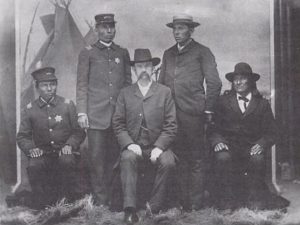
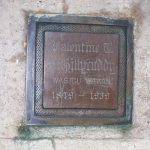 the Black Hills, and to confirm that gold had been discovered there. It was during this excursion that he climbed Harney Peak. There had been other white men to climb the mountain, including General George Custer, but they all stopped just short of the peak, because it was to difficult to make it…something I think I can relate to. McGillycuddy angled a felled tree into a crevice in the granite, and made his way to the very top. I can totally feel his elation and sense of accomplishment, since I have felt the same way myself. My guess is that it would not be the last trip he made to the top either. That mountain has a way of calling you back for a second and even third or more visits.
the Black Hills, and to confirm that gold had been discovered there. It was during this excursion that he climbed Harney Peak. There had been other white men to climb the mountain, including General George Custer, but they all stopped just short of the peak, because it was to difficult to make it…something I think I can relate to. McGillycuddy angled a felled tree into a crevice in the granite, and made his way to the very top. I can totally feel his elation and sense of accomplishment, since I have felt the same way myself. My guess is that it would not be the last trip he made to the top either. That mountain has a way of calling you back for a second and even third or more visits.
McGillycuddy became a friend to Crazy Horse, and in fact was with him when he died after being stabbed at Fort Robinson, Nebraska in 1877. After that time, the Lakota Sioux named McGillycuddy Tasunka Witko Kola, 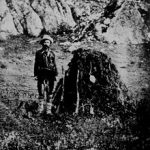 which means “Crazy Horse’s Friend” in English. Other Native Americans named McGillycuddy Wasicu Wakan, which means “Holy White Man” in English. Dr Valentine McGillycuddy did lead a very amazing life. His first wife died, and he moved to San Francisco to continue his medical practice. There he married Julia Blanchard. After he passed away in 1939, Julia wrote a book about his life called “McGillycuddy, Agent” which was how he signed his name during his favorite role in life. He was a friend to the Indians, and did his best to educate them by building a school for the children. He was a calming influence on the relationship between the Indians and the White Man. It is quite fitting then that his ashes be entombed on the mountain that he loved. It gives a totally different feeling to the little plaque that is there…if one researches it.
which means “Crazy Horse’s Friend” in English. Other Native Americans named McGillycuddy Wasicu Wakan, which means “Holy White Man” in English. Dr Valentine McGillycuddy did lead a very amazing life. His first wife died, and he moved to San Francisco to continue his medical practice. There he married Julia Blanchard. After he passed away in 1939, Julia wrote a book about his life called “McGillycuddy, Agent” which was how he signed his name during his favorite role in life. He was a friend to the Indians, and did his best to educate them by building a school for the children. He was a calming influence on the relationship between the Indians and the White Man. It is quite fitting then that his ashes be entombed on the mountain that he loved. It gives a totally different feeling to the little plaque that is there…if one researches it.

